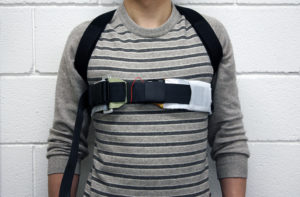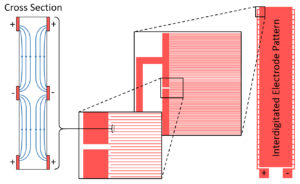Breathing is the most consistent source of kinetic energy in the human body, as it produces a large circumferential displacement in the chest, even during sleep. This oscillation is one of few mechanisms in the human body that can also be exploited non-invasively for energy harvesting.
The National Science Foundation’s ASSIST (Advanced Self-Powered Systems of Integrated Sensors and Technologies) Engineering Research Center is pushing efforts to harvest energy from the oscillations of the human chest during breathing in a wearable package to power biochemical, biopotential, and environmental sensors. Researchers at North Carolina State University (NCSU) and Pennsylvania State University (PSU) are investigating the integration of flexible piezoelectric polymers into textiles to achieve this goal.
A century-old discovery
The piezoelectric effect was discovered in the late nineteenth century, with its first application shortly after, during World War I. Since then, piezoelectric materials have been implemented in numerous sensor and actuator applications. As actuators, these smart materials use the converse piezoelectric effect to produce stress when an electric field is applied. The opposite of that is the direct piezoelectric effect, where the material produces voltage when stress is applied. One can readily deduce how the latter phenomenon can be used to harvest energy from ambient motions.
Polyvinylidene fluoride (PVDF) is a polymer that was demonstrated to be piezoelectric in 1969 and is the most widely used piezoelectric polymer. More recently, the copolymer of PVDF, polyvinylidene fluoride-trifluoroethylene or P(VDF-TrFE) was developed. Model-based predictions estimate its performance to be similar to that of PVDF even though it has higher elasticity.
Tests at PSU have shown that a 100cm2 sheet of 28m thick PVDF film is capable of producing 1mW peak power when repetitively stretched and relaxed to 1 percent strain at a frequency of 1Hz under an optimal load of 4.4M. Doubling the area of this material doubles the power output at half the optimal load. Hence, the copolymer P(VDF-TrFE) could potentially provide this level of performance while requiring only about half to two-thirds of the stretching force, making it particularly suitable for energy harvesting from the human body.
Calculating variables
The voltage generated by a piezoelectric material varies based on the direction it is deformed (i.e. the axis along which stress is applied). This variation is determined by the initial poling process, which involves the application of heat and a large electric field to induce molecular conformational changes in the material that produce a macroscale piezoelectric response. Generally, material deformation along the poling direction, which follows the electric field applied during the poling process, produces the highest voltage.

For example, a sheet of PVDF film with electrodes on the faces will polarize the material along its thickness direction and, as a result, the film will produce more voltage when it is pressed in that direction with a certain amount of stress than when its ends are clamped and pulled in the length direction with that same amount of stress. Since the latter is more useful in a wearable chest energy harvesting garment, interdigitated electrodes (IDEs) are being incorporated to pole the material along the length direction.
IDEs consist of electrode lines that are tens of microns thick and span across the surface of the material like fingers spaced hundreds of microns apart. Consecutive fingers alternate as positive and negative electrode lines, with all lines of identical voltage polarity being connected. The IDE pattern is mirrored on the opposite side of the film for efficient poling. This electrode design aligns the poling direction to the stretching directions when the stretching is occurring in the length direction (i.e. perpendicular to both the thickness and the electrode fingers).

Other energy harvesters have been developed that use motion from the wrist or elbow to generate energy; however, these types of energy generators often require a wide range of motion and a large amount of force to operate. Alternatively, the optimal amount of strain needed to generate power from PVDF IDEs is very small, so they have potential to be used in low-power wearables by harvesting energy from small, repetitive movements in the body, such as breathing as it is a fairly steady, constant source of small motion in the body.
Additionally, the piezoelectric polymer film is flexible so that it is more comfortable to wear than other devices. The film’s flexible behavior also makes it easier to integrate into textiles, which are also flexible.
Textiles can also be used to control the amount of strain that the device experiences. There is a very narrow amount of strain that the PVDF film can operate under; 1 percent strain is ideal for producing power but more than 3 percent strain can cause failure. The amount of stretch in the textile can be controlled by using different yarns and knit structures in the textile design.
Incorporating the PVDF film into a textile form factor, such as a shirt or a chest band, is one way to make the device wearable. In order to harvest energy from the motion of breathing, the energy harvesting device must be worn around the chest for an extended amount of time. Incorporating the device into a shirt allows the device to be worn around the chest in an unobtrusive way.
Anytime a device is to be worn on the body, there are special needs to consider; it’s important to design the wearable device with fit and comfort in mind. This particular device has to allow the chest to expand and contract without constricting it. If the device restricts breathing or is uncomfortable, then the wearer is much less likely to be able to wear it for an extended amount of time, which would defeat the purpose of the device.
Ideally, any strain energy harvesting wearable device would be designed in a way that the wearer does not even notice that it is there.
Allison Bowles is a product developer with the Nano-EXtended Textiles (NEXT) Research Group at NCSU. She works on textile integration of wearable technology.
Tahzib Safwat is a Ph.D. student at the Mechatronics Research Lab at Penn State. He works on wearable actuators and sensors that use smart materials.
 TEXTILES.ORG
TEXTILES.ORG


